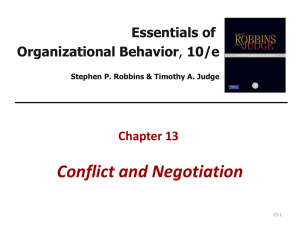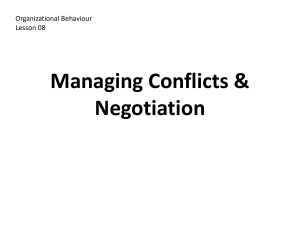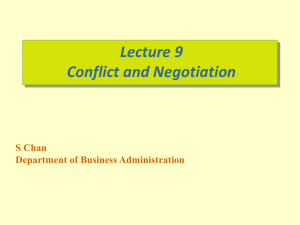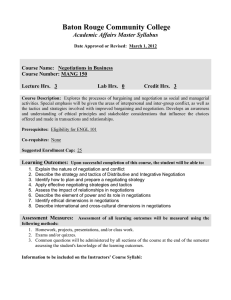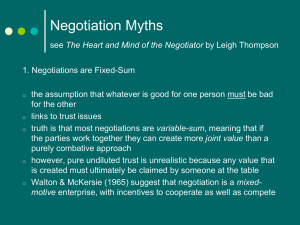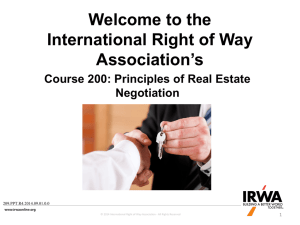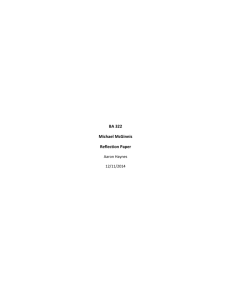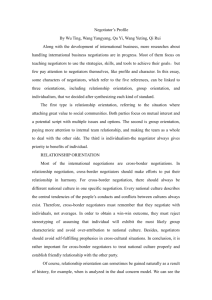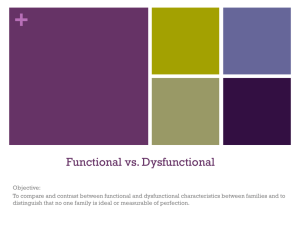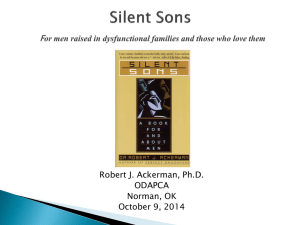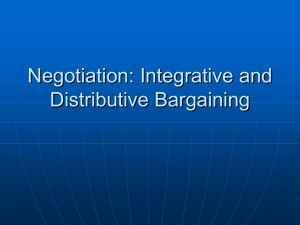PPT 13
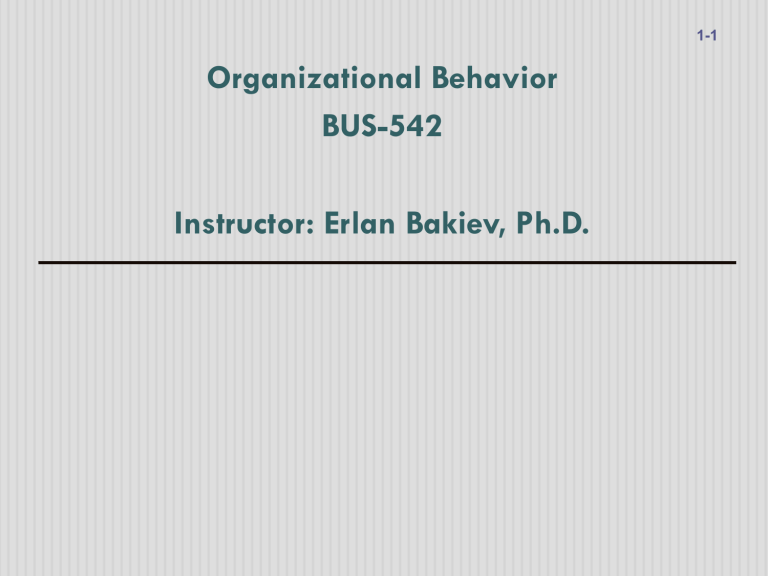
Organizational Behavior
BUS-542
Instructor: Erlan Bakiev, Ph.D.
1-1
Essentials of
Organizational Behavior, 11/e
Stephen P. Robbins & Timothy A. Judge
Chapter 13
Conflict and Negotiation
13-2
After studying this chapter, you should be able to:
13-3
1.
2.
3.
4.
5.
6.
Define conflict and differentiate between the traditional, interactionist and managed-conflict views of conflict.
Outline the conflict process.
Contrast distributive and integrative bargaining.
Apply the five steps of the negotiation process.
Show how individual differences influence negotiations.
Describe cultural differences in negotiations.
Conflict Defined
13-4
Process that begins when one party perceives that another party has negatively affected, or is about to negatively affect, something that the first party cares about (Thomas, 1992).
Transitions in Conflict Thought
13-5
Traditional View
All conflict is harmful and must be avoided
Interactionist View
Conflict is encouraged to prevent group from becoming stale (Dreu and Van de Vliert, 1997)
Resolution Focused View
Conflict is inevitable but we should focus on productive conflict resolution (Peterson and Behfar,
2003)
13-6
Functional Vs. Dysfunctional Conflict
Functional: improves group performance
Dysfunctional: hinders group performance
Assessing Focus of Conflict:
Task – work content and goals
Relationship – interpersonal
Process – how the work is done
13-7
Desired Conflict Levels
Source of
Conflict
Task
Relationship
Process
Low
Level of Conflict
Moderate
Functional
Dysfunctional
Functional Dysfunctional
High
Dysfunctional
13-8
The Conflict Process
Stage I: Potential Opposition
13-9
Communication
Barriers Exist
Too Much or Too Little
Structure
Group Size, Age, Diversity
Organizational Rewards,
Goals, Group Dependency
Personal Variables
(Glomb and Liao, 2003)
Personality Types
Emotionality
Stage II: Cognition and Personalization
13-10
Potential for conflict is actualized
Parties “make sense” of conflict by defining it and its potential solutions
Emotions play a major role in shaping perceptions
Perceived Conflict – awareness needed for actualization
(Pondy, 1967)
Felt Conflict - emotional involvement - parties experience anxiety, tension, frustration, or hostility
13-
11
Stage III: Intentions
The decision to act in a given way
Inferred (often erroneous) intentions may cause greater conflict (Baron, 1989)
Stage IV: Behavior
13-12
Where conflict becomes visible
Usually overt attempts to implement each party’s intentions
May become an inadvertent stimulus due to miscalculations or unskilled enactments
Functional Conflicts: confined to lower range of continuum – subtle, indirect, and highly controlled
Dysfunctional Conflicts: upper range – highly destructive activities such as strikes and riots
13-13
Stage V: Outcomes
Functional (Nijstad and Kaps, 2008; Zellmer-
Brugn et al., 2008):
Improves decision quality
Stimulates creativity and innovation
Encourages interest and curiosity
Problems are aired
Accepts change and self-evaluation
Dysfunctional:
Group is less effective
Cohesiveness and communications are reduced
Leads to the destruction of the group
13-14
Creating Functional Conflict
(Sommerfield, 1990)
Managers can reward dissent and punish conflict avoiders
Managers must learn to accept bad news without sending cues that conflict is unacceptable
Negotiation
13-15
Process in which two or more parties exchange goods or services and attempt to agree on the exchange rate for them (Robbins and Judge, 2012)
13-16
Bargaining Strategies (Walton and
McKersie, 1965)
13-17
Distributive Bargaining Zones
A’s Target
Point
A’s
Aspiration
Range
A’s
Resistance
Point
Player
A
Player
B
Settlement
Range
B’s Target
Point
B’s
Aspiration
Range
B’s
Resistance
Point
Necessary Conditions for Integrative Bargaining
(Thomas, 1992)
13-18
Parties must be open with information and candid about their concerns
Both parties must be sensitive regarding the other’s needs
Parties must be able to trust each other
Both parties must be willing to be flexible
13-19
The Negotiation Process
(Bazerman and Neale, 1992;Curhan, et l., 2009)
BATNA
13-20
Individual Differences in Negotiation
Personality (Amanatullah et al., 2008)
Little evidence to support
Disagreeable introvert is best
Moods & Emotions (Watson and Hoffman,
1996; Walters et al., 1998)
Showing anger helps in distributive negotiations
Positive moods help integrative negotiations
Gender
Men are slightly better
Many stereotypes – low power positions
Women’s self-image as negotiators is poor
13-21
Global Implications
Conflict and Culture:
Insufficient research at this point
Initial evidence does suggest some differences in tactics and attitude
Cultural Differences in Negotiations:
Negotiating styles clearly vary across national cultures
Implications for Managers: Managing Conflict
13-22
Use in the appropriate situations:
Competition – quick action is vital
Collaboration – to gain commitment with consensus
Avoidance – the issue is trivial
Accommodation – when you’re wrong
Compromise – opponents have equal power and hold mutually exclusive goals
Implications for Managers: Improving Negotiation Skills
13-23
Set Ambitious Goals
Pay Little Attention to Initial Offers
Research Your Opponent
Address the Problem, Not the Personalities
Be Creative - Emphasize Win-Win Solutions
13-24
Keep in Mind…
Conflict is an inherent part of organizational life: probably necessary for optimal organizational function
Task conflict is the most constructive
Most effective negotiators use both types of bargaining and know the appropriate tactics
2.
3.
4.
5.
6.
13-25
1.
Summary
Defined conflict and differentiated between the traditional, human relations, and interactionist views of conflict.
Outlined the conflict process.
Contrasted distributive and integrative bargaining.
Applied the five steps of the negotiation process.
Showed how individual differences influenced negotiations.
Described cultural differences in negotiations.
